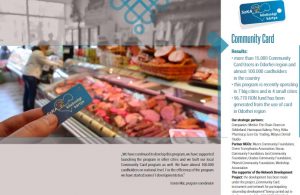Romania’s Community Card Program – turning local shoppers and businesses into philanthropists
11 Jun 2018

In 2009, the Community Foundation of Odorheiu Secuiesc partnered with a local supermarket chain to launch the SOLCARD, or Community Card. The Community Card is essentially a customer reward card with a social twist. Most customer reward cards give some percentage or points back to the consumer that can be redeemed for reimbursement in the form of coupons or discounts. The Community Card Program does the same, offering users a percentage back on their purchase. But the difference between the Community Card Program and other rewards cards is that the savings to the consumer are matched with a donation to the Community Foundation of Odorheiu Secuiesc from the participating company. So every time a local individual uses their card they save money on their purchase, and the company contributes to the community foundation’s Local Development Fund.
Once the total amount in the Local Development Fund reaches a threshold of about $3,000 USD, a call for proposals goes out to local NGOs. The staff of the Community Foundation of Odorheiu Secuiesc then reviews the proposals, selecting three high-visibility, short-term projects and Community Card users vote on which local project should receive funding. Grants are awarded and, once completed, the community foundation reports back on results to Community Card users. All told, this has generated 76 grants totaling 261,312 RON (approximately $70,000 USD) since the program began. Because the grants are selected through a participatory process, and supported projects are required to have a voluntary element, the program has engaged nearly all Community Card users in the grant decision-making process, and thousands as volunteers. Furthermore, the online community of Community Card users has opened up additional ways to participate in local philanthropy: either through donations of time or money to the community foundation itself, or to other organizations in the community through various annual campaigns. Local corporate giving has increased as well, as businesses have watched the number of users, who also happen to be their customers, grow and engage in the Community Card Program.
This model has proven highly effective for starting a local conversation about philanthropy. Everyone has to eat. And everyone would like to save some money on the food they buy. Rather than presume an entire community was ready to have a discussion about philanthropy, the Community Card Program turned those necessary actions into an income stream, and developed a communications loop that engaged local people in the process. As they voted on projects they liked, local citizens engaged in philanthropy, and follow-up communications offered them additional ways to volunteer, learn or give locally. For local businesses the program offers a sustainable vehicle for CSR that generates data about consumption, helps them target their marketing and solidifies their local brand.
Over the last decade we have seen the program grow, with nearly every family in Odorheiu Secuiesc participating, 25 new businesses partners joining – above and beyond the first supermarket partner, and the franchising of the model to nine other community foundations around Romania (with more than 150,000 families using the card on a regular basis across the country). Recently, with the support of USAID, the Community Card Program expanded to Serbia. The local partner there is the Ana and Vlade Divac Foundation, who aims to involve five communities in the program in the first year. In each new iteration of the Community Card Program, the organizing partner receives 20% of the income generated, to help maintain and grow the initiative.
One of the challenges has been getting new entrepreneurs signed up to the program. The initial Community Card Program revolved around a small plastic key fob with a barcode, unique to the user, on the back. As the program grew, numerous small businesses wanted to join but didn’t have barcode readers. This led to various developments including partnership with a business that sells register and point of sale infrastructure to small businesses, the development of a digital platform which serves as a virtual “back end” to the program, and inventing a variety of new ways for small businesses to partner. This may involve small businesses offering ongoing discounts to Community Card holders, committing to contribute a percentage of their total sales to the Local Development Fund, or such businesses may choose to offer one-time specials or sales that can be communicated via email newsletters to Community Card users.
As the Community Card Program continues to grow and evolve into an effective platform for corporate social responsibility, community philanthropy and cause-related marketing, our team is exploring a variety of new tools and services that might be useful to Community Card stakeholders. Though community foundations are natural partners to coordinate such a program, the team is also exploring a variety of partnership models that might expand beyond community foundations into serving other kinds of foundations in regions that do not yet have community foundations as such. This will help encourage community philanthropy, the main goal of the program, and may even lay the groundwork for new community foundations in the future.
By: Istvan Mar, Community Card Programe Manager, Community Foundation of Odorheiu Secuiesc
For more information about the Programme, to share ideas on how it might be improved, or if you would like to implement it in your own community, reach out to Istvan Mar (istvanmar@szka.org), Chris Worman (Vice President of the Community Foundation of Odorheiu Secuiesc, Alliances and Program Development, cworman@techsoupglobal.org), Ana Koeshall (Director of the Ana and Vlade Divac Foundation, Serbia, ana.k@divac.com), or Željko Mitkovski (Project Coordinator of the Ana and Vlade Divac, Serbia, zeljko.mitkovski@divac.com).


